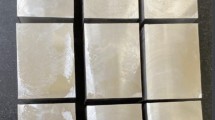Abstract
This paper presents a contribution to hardened tool steel milling studies. High-speed milling is largely utilized to substitute some EDM and polishing operations, mainly in finish machining of dies and molds made of hardened tool steel. Tool path and tool inclination are parameters used to identify adequate milling strategies, mainly to super finishing operations. Tool strategy is a very important variable in this kind of operations, since it may generate either long or short tool life, either low or high workpiece surface roughness. In this work, several milling experiments were performed in a circular convex AISI D6 hardened steel workpiece, having as input variables feed direction (upward and downward following the circular form of the surface) and tilt angle (tool inclination). Downward tool path resulted in longer tool lives, regardless the tilt angle utilized. Moreover, in upward tool path, workpiece surface roughness was not adequate to a process which aims to replace EDM. In downward tool path and tilt angle 0°, workpiece surface roughness values were adequate to EDM substitution along the whole tool life and the ratio of axial and radial cutting force components was higher than in upward tool path, which was determinant to the generation of low values of surface roughness.


















Similar content being viewed by others
References
Altintas Y, Kersting P, Biermann D, Budak E, Denkena B, Lazuglu I (2014) Virtual process systems for part machining operations. CIRP Ann Manuf Technol 63(2):585–605. doi:10.1016/j.cirp.2014.05.007
Arnone M (1998) High performance machining. Hanser Gardner Publication, Cincinnati
Childs T, Maekawa K, Obikawa T, Yamane Y (2004) Metal machining: theory and applications. Elsevier Ltd, Oxford (digital edition)
Diniz AE, Marcondes FC, Coppini NL (2010) Tecnologia da Usinagem dos Materiais. Artliber Editora, São Paulo (In Portuguese)
Sandvik Coromant (2015) Criação de superfícies esculpidas, http://www.sandvik.coromant.com/pt-pt/knowledge/milling/application_overview/profile_milling/generation_of_sculptured_surfaces/pages/default.aspx. Accessed 26 Feb 2015 (in Portuguese)
Sandvik Coromant (2015b) Lista de verificação e dicas de aplicação. http://www.sandvik.coromant.com/pt-pt/knowledge/milling/application_overview/profile_milling/application_checklist/pages/default.aspx. Accessed 03 Mar 2015 (in Portuguese)
Sandvik Coromant (2000) Fabricación de Moldes y Matrices—guia de aplicación. C-1120.2 SPA. (in Spanish)
Souza AF, Machado A, Beckert SF, Diniz AE (2014) Evaluating the roughness according to the tool path strategy when milling free form surfaces for mold application. In: 6th CIRP International conference on high performance cutting, HPC2014, p 188–193. doi: 10.1016/j.procir.2014.03.089
Beak BD, Fox-Rabinovich GS (2014) Progress in high temperature nanomechanical testing of coatings for optimising their performance in high speed machining. Surf Coat Technol 225:102–111
Davim JP (2008) Machining: fundamentals and recent advances. Springer Verlag, London (digital edition)
Davim JP (2010) Surface Integrity in Machining. Springer Verlag, London (digital edition)
Devillez A, Dudzinski D (2007) Tool vibration detection with eddy current sensors in machining process and computation of stability lobes using fuzzy classifiers. Mech Syst Signal Process 21:441–456
Koshy P, Dewes RC, Aspinwall DK (2002) High speed end milling of hardened AISI D2 tool steel (~58 HRC). J Mater Process Technol 127:266–273
de Lacalle NL, Lamikiz A (2009) Machine tools for high performance machining. Springer Verlag, London (digital edition)
Urbanski JP, Koshy P, Dewes RC, Aspinwall DK (2000) High speed machining of moulds and dies for net shape manufacture. Mater Des 21:395–402
Ozturk E, Tunc LT, Budak E (2009) Investigation of lead and tilt angle effects in 5-axis ball-end milling processes. Int J Mach Tools Manuf 49:1053–1062. doi:10.1016/j.ijmachtools.2009.07.013
Scandiffio I, Diniz AE, Souza AF (2016) Evaluating surface roughness, tool life, and machining force when milling free-form shapes on hardened AISI D6 steel. Int J Adv Manuf Technol 82:2075–2086. doi:10.1007/s00170-015-7525-0
Kull Neto H, Diniz AE, Pederiva R (2015) Influence of tooth passing frequency, feed direction, and tool overhang on the surface roughness of curved surfaces of hardened steel. Int J Adv Manuf Technol 82:753–764. doi:10.1007/s00170-015-7419-1
Kull Neto H, Diniz AE, Pederiva R (2016) The influence of cutting forces on surface roughness in the milling of curved hardened steel surfaces. Int J Adv Manuf Technol. doi:10.1007/s00170-015-7811-x
Castanhera IC, Diniz AE (2015) Influence of tilt angle and feed direction on surface roughness and cutting forces in high speed milling of hardened tool steel. In: Annals of the 23rd ABCM International Congress of Mechanical Engineering - COBEM
Costa e Silva ALV da, Mei PR (2013) Aços e Ligas Especiais. 3rd revised edition, Edgard Blucher editora, São Paulo (in Portuguese)
Trent E, Wright PK (2000) Metal cutting. Butterworth-Heinemann, Boston
Acknowledgements
The authors acknowledge DEMM-FEM/UNICAMP, Sandvik Coromant Brazil and mainly “Fundação de Apoio à Pesquisa do Estado de São Paulo—FAPESP” (Process Number 2013/00551-7) for making this study possible.
Author information
Authors and Affiliations
Corresponding author
Additional information
Technical Editor: Márcio Bacci da Silva.
Rights and permissions
About this article
Cite this article
da Costa Castanhera, I., Diniz, A.E. Cutting forces, surface roughness and tool life in high-speed milling of hardened steel convex surface. J Braz. Soc. Mech. Sci. Eng. 39, 3555–3570 (2017). https://doi.org/10.1007/s40430-017-0775-z
Received:
Accepted:
Published:
Issue Date:
DOI: https://doi.org/10.1007/s40430-017-0775-z




